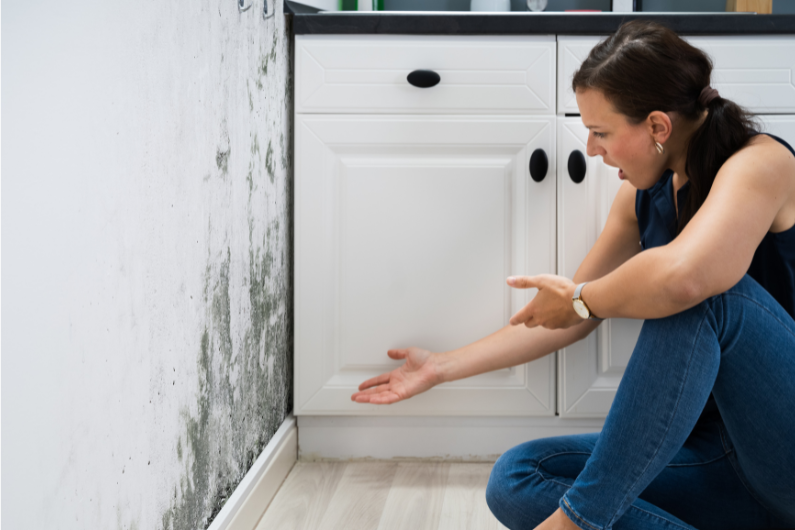
Finding those white, gray, or light brown spots in the basement or shower can be unnerving. As long as there is moisture and water to sustain it, it will continue to spread. Sometimes developing a bad smell. So, it can get out of hand very quickly, especially in areas that you don’t use too often. Like between the walls or across the basement.
Among household odors, mildew is, without a doubt, one of the worst. The room starts to smell pungent and stale, quite like the odor of rotting wood. This smell can develop overnight and become more prominent in humid and damp areas. And getting rid of it is an ongoing effort.
Unless you know exactly what you are doing. Don’t worry: with just a couple of pantry items and cleaning strategies, you can give your house a deep clean. And freshen up the room, particularly in low-ventilated rooms.
Discover professional insights on this topic from the eBook

Why does my room smell like mildew?

Moisture is the main culprit behind the mildew build-up. Mildew can form on any organic matter. Such as wood, wallpaper, wall, etc. During the winter months, when the heating is at full blast, and you keep the windows shut, mildew starts to flourish. This is when the home can start to smell like mildew.
Other mildew causes include:
- Poor ventilation
- Humidity
- Water damage
- Wet or damp fabrics
- Water leaks behind walls
- Lack of sunlight
- Debris and dirt
Although you can’t avoid mold spores from entering the home, you can stop the mildew from growing. If your house smells musty but has no mold, then the room might have poor airflow, high humidity, soiled carpet, dirty HVAC equipment, or a plumbing leak.
What absorbs the smell of mildew?
Many different areas of your home can absorb the smell of mildew. Germs and bacteria can permeate wood furniture and lead to an “old smell.” Mildew can also develop near or in areas where there is water dripping, like gutters or drainpipes.
It is very common to find mildew around bathtubs, showers, near HVAC vents, and ceilings. Or on the wall close to the clothes dryer vent.
Is the smell of mildew harmful?

If the mildew is left unmanaged, it has a higher odds of causing respiratory problems. It can also trigger allergies, respiratory infections, or asthma. Avoiding cleaning the mildew can be especially problematic for individuals with sensitive health, like those with existing respiratory problems, skin problems, and a weaker immune system.
How do you get the mildew smell out of a room?
The mildew smell doesn’t go away on its own. And spraying some air freshener can be a temporary solution. To get rid of the odor, you need to find the source. If you smell mildew, check for any visible signs of spotted walls, doors, furniture, fabric, etc.
The fastest way to eliminate the musty aroma is to open the windows and bring fresh air into the room. Getting rid of the stale air should be a top priority. Dust the surfaces thoroughly and regularly, and mop and vacuum the floors to remove any lingering smell.
Give the shower drain and bathtub a deep clean. Take a scrub brush and a tile and tub cleaner and scrub the mildew away. Then use a water spray to wash away the residue. To remove the mildew, disinfect the dishwasher and clean the washing machine.
How to remove mildew from grout

Mildew, grime, and dirt can easily stick to the grout. If you want to use a natural solution that can remove the spots and smell, the option below can help.
- Mix equal parts of lemon juice and vinegar, with a bit of baking soda until it forms a paste.
- Take a toothbrush and apply the solution to the grout.
- Do a thorough scrub.
- Wait for 5 minutes before rinsing the grout with warm water.
If there is still some leftover mildew, apply 3% hydrogen peroxide to the grout. Let it sit for 10 minutes and rinse with warm water. Want to know how to clean mildew from hard-to-reach places? If the area with mildew is too narrow or tiny, you can use cotton balls.
Soak the cotton ball with hydrogen peroxide, put it on the grout, and wait for a couple of hours. Rinse the grout with warm water.
How to remove mildew from tile and bathroom fixtures

Another trick for cleaning mildew is to use a simple white vinegar solution. Take a spray bottle and fill it with distilled, undiluted white vinegar. Spray the vinegar on the spots you see mildew and let it sit for 1 hour. Use a damp, clean cloth to remove the mildew.
If the stains are difficult to remove, replace the bleach with 3% hydrogen peroxide. All you have to do is apply the peroxide to the stain and let it sit for 10 minutes. Use a damp cloth to wipe it away.
How do you freshen the air in a closed room?

Use a dehumidifier in rooms where it is hard to ventilate. A dehumidifier is an excellent choice for removing moisture from a damp room, like the basement. It can decrease the odor. Want to know how to get rid of the mildew smell in the basement naturally? Another trick is to decorate the room with houseplants that can naturally clean the air. Such as a peace lily, English ivy, Chinese Evergreen, spider plant, etc.
What is the most powerful odor eliminator?

Borax is the best basement odor eliminator due to its unique pH level. Borax has around a 9.3 pH level and is alkaline. Its highly alkaline nature makes it a potent mildew smell remover. But, when cleaning with Borax, make sure to wear gloves, as it can irritate the skin. Don’t consume large quantities of this household cleaner. It can cause diarrhea, vomiting, and nausea.
Further tip - HOCl Fogging

There is no doubt that the methods described above are effective. However, we can hear your voice saying, "I don't have time for that!". So here is our advice to you.
There is a chlorine-based disinfectant called HOCl which can control germs at extremely low concentrations that are safe for the human body. By fogging this disinfectant with a specially designed fogger, the HOCl ingredients can be delivered by dry mist to surfaces throughout the space without any labor. Since removing bothersome odors is almost same with controlling germs, this system can also serve to improve daily cleanliness.
Reference: HOCL (HYPOCHLOROUS ACID WATER): ALL YOU NEED TO KNOW
There are several types of specialized foggers available, but the stationary type is the most reasonable to operate. All you have to do is set it and forget it, and before you know it, you will have a clean and hygienic space free from mildew smell.
Reference: 4 BENEFITS OF HOCL FOGGING (HYPOCHLOROUS ACID)
Discover professional insights on this topic from the eBook below. Store the data and make it yours.

References
https://www.maids.com/cleaning-hacks/clean-banish-mildew-real/
https://www.grove.co/blog/get-rid-of-musty-smells
https://extension.missouri.edu/publications/gh5928
https://www.thespruce.com/identifying-mold-vs-mildew-4799138
https://www.cleanipedia.com/gb/in-the-home/what-is-mildew-and-how-to-deal-with-it.html
https://www.nhs.uk/common-health-questions/lifestyle/can-damp-and-mould-affect-my-health/


